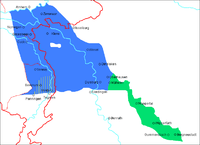South Guelderish
South Guelderish (Dutch: Zuid-Gelders, German: Südgeldersch, Kleverländisch) refers to the easternmost group of Dutch dialects spoken along the lower Rhine (Dutch Nederrijn and German Niederrhein). In its narrower sense, the term refers strictly to the Rivierenlands, Nijmeegs, and Liemers sub-dialects; in its broader sense, the term encompasses also North Limburgish in the Netherlands and Kleverlander (around Cleves; Dutch Kleverlands, German Kleverländisch) and East Bergish in Germany. South Guelderish (in the narrow sense) — especially Rivierenlands — is sometimes included as part of Brabantic, a more widely spoken Dutch dialect and the closest relative of South Guelderish. Alternatively, it is considered to extend southward into Northern Limburg until the Uerdingen line. It is arguably more appropriate to group South Guelderish (narrow sense), North Limburgish, Kleverlander, and East Bergish into one dialect group—East Dutch.

| This article is a part of a series on |
| Dutch |
|---|
| Dutch Low Saxon dialects |
| West Low Franconian dialects |
| East Low Franconian dialects |
|
In the Netherlands, South Guelderish is spoken in the following regions: North Limburg, the Veluwezoom National Park, Rijk van Nijmegen, Land van Maas en Waal, the Bommelerwaard, the Tielerwaard, the Betuwe, Land van Cuijk and Liemers.
Status
The status of East Dutch differs greatly between the Netherlands and Germany. On the Dutch side, East Dutch is subject to the influence of Standard Dutch. Since it is a Dutch dialect, it is already similar enough to the standard language to have had relatively little influence. In Germany, however, since 1713, when Prussia took control of the area, Kleverlander and East Bergish have been in retreat under the pressure of Standard German to which they are only distantly related. The dialects, mainly in their vocabulary, have been influenced.
Furthermore, large-scale industrialization in the Cleves–Duisburg area in Germany, as well as the resulting immigration, during the late 19th century and the 20th century, has greatly reduced its use today, leaving very few native speakers. For example, in Duisburg (though traditionally within the South Guelderish area), it has virtually died out. (See Duisburg Platt Dialect).
As noted before, South Guelderish is sometimes included within Brabantic. That is because there exists no tight isogloss bundle between the Brabantic and South Guelderish dialects. Instead, change occurs in two individual steps: the alt-oud isogloss, between Groesbeek and Nijmegen, and the ies-ijs and the huis-huus isoglosses west of Nijmegen.
Trivia
- A dialect of South Guelderish origin spoken in the United States is Pella Dutch.
- The Limburgish band Rowwen Hèze sings in North Limburgish, a subdialect of South Gelderish.